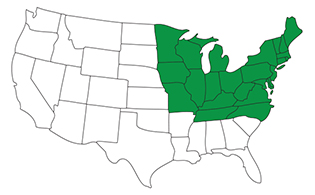
Bluegrass Sod Webworm
Parapediasia teterrella
The Bluegrass Sod Webworm is a lawn-damaging insect known for attacking Kentucky Bluegrass, Perennial Ryegrass, Fine Fescue and Creeping Bentgrass. Also known as Parapediasia teterrella, this lawn pest infests yards as both a caterpillar and moth, affecting much of the Northeast and Midwest.
Identify

Crown & Thatch
An adult Bluegrass Sod Webworm can be identified by its white head and snout that are both gray to light brown on the undersides. The forewings of this lawn-destroying insect have seven spots along the wing tip, and a curved, brownish-orange line that runs across the wing, just inside the tip—its veins are usually distinctly lighter in color. The larvae of the Bluegrass Sod Webworm have blackish-brown head capsules and translucent, yellowish bodies (which appear green after feeding). Adults are often seen flying out of a lawn when disturbed. Bluegrass Sod Webworm lawn damage initially begins as thinning of the grass, followed by small brown patches appearing in the lawn. As this lawn pest's larvae develop, these brown spots can grow to several inches in diameter. A close examination of your yard will reveal short green stubs of grass left behind by the grazing larvae. Silk-lined tunnels in the thatch or upper soil may also be found. Severe Bluegrass Sod Webworm infestations can result in large, irregular patterns of sparse turf. The damage is comparable to scalping your lawn—or mowing it too low—and the effects are somewhat similar. Damage from this lawn insect is often found on south-facing slopes. Well-maintained grass can mostly tolerate this damage, but stressed yards may begin to show signs of dying off as crowns are exposed to sunlight.
Life Cycle
In cool-season and transition-zone states, it's completely normal to experience two generations of Bluegrass Sod Webworm per year. The second generation's larvae overwinter in silk-lined chambers inside the soil. Some Sod Webworm species experience only one generation per year, but these lawn pests also overwinter as larvae.

Control
There are two methods for controlling Bluegrass Sod Webworms that TruGreen® recommends: 1. Use professionally applied pest control designed to prevent excess lawn pest populations, which can cause damage to your lawn 2. Kill insects, grubs and other lawn pests before they have a chance to damage your lawn Proper mowing and watering techniques can also help foster a healthy lawn that's more tolerant to lawn pest attacks—plus you'll get a lawn you'll want to live on in the process.







